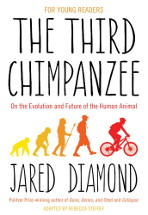The third chimpanzee for young people: On the evolution and future of the human animal by Jared Diamond

Oneworld Publications, 2014. ISBN 9781780746043
Recommended (Age: 14+) As his title suggests, Jared Diamond sees
human beings as the product of evolution, and of its guiding
principle natural selection. To this Pulitzer Prize-winning
Professor of Geography, evolution raises more questions than it
answers. His hypotheses provide some challenging insights into human
behaviour. Having traced the ascent of humankind, Diamond turns his
attention to its impact on the planet. After considering climate
change, the extinction of species and the loss of Indigenous
peoples, he concludes that the negative effects of the growth of
human power have the potential to overturn the balance of nature.
Despite the threat that humanity poses to its own existence, Jared
Diamond declares that he is 'cautiously hopeful' because people can
learn from the past.
Rebecca Stefoff's adaptation of Jared Diamond's original work
explains complex concepts clearly and concisely. Subjects such as
sexuality, death, self-destructive behaviours and genocide are
examined in a frank, detached, informative manner that combines
scientific inquiry with the sweep of human history. Occasional
flashes of emotion are revealed when the author reflects on the
disappearance of a species or culture. Scientific terms are defined
with elaboration rather than avoided or simplified, and their
meanings are clarified further in a useful glossary. Black and white
illustrations and photographs enhance the text.
There are at least two reasons to read The third chimpanzee.
The first is to find out how a scholar can interpret evidence drawn
from a broad knowledge of the human and natural world. The second is
to share a thought-provoking contemplation of the evolution of
humanity and civilisation. Whether or not readers agree with Jared
Diamond's interpretation of life on Earth, they may find themselves
pondering the issues raised, long after they have finished reading
the book.
Elizabeth Bor